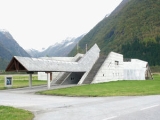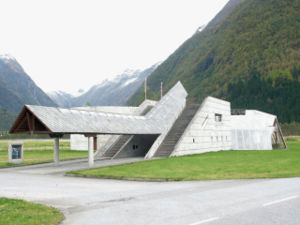
Sverre Fehn
Encyclopedia
Sverre Fehn was a Norwegian
architect. The architect’s highest international honour came in 1997, when he was awarded both the Pritzker Architecture Prize and the Heinrich Tessenow Gold Medal
.
, Buskerud
. He received his architectural education shortly after World War II
in Oslo
, a crisis course that would later become an independent school under various names during the next decades, today known as the Oslo School of Architecture and Design
. He quickly became the leading Norwegian architect of his generation.
 In 1952–1953, during travels in Morocco
In 1952–1953, during travels in Morocco
, he discovered primitive architecture, which was to deeply influence his future work. Later he moved to Paris
, where he worked for two years in the studio of Jean Prouvé
, and where he knew Le Corbusier
. At his return in Norway, in 1954, he opened a studio of his own.
At the age of 34 Fehn gained international recognition for his design of the Norwegian Pavilion at the 1958 Brussels
World Exhibition. In the 1960s he produced two works that have remained highlights in his career: the Nordic Pavilion at the Venice Biennale
(1962) and the Hedmark museum
in Hamar
, Norway (1967–1979). Fehn's other notable works include Schreiner House in Oslo (1963) and Busk House at Bamble
(1990); however, few of his projects were effectively built.
He taught in Oslo's School of Architecture
from 1971-1991 as a professor and principal from 1986-1989, as well as at the Cranbrook Academy of Art in Bloomfield Hills, Michigan
.
Norway
Norway , officially the Kingdom of Norway, is a Nordic unitary constitutional monarchy whose territory comprises the western portion of the Scandinavian Peninsula, Jan Mayen, and the Arctic archipelago of Svalbard and Bouvet Island. Norway has a total area of and a population of about 4.9 million...
architect. The architect’s highest international honour came in 1997, when he was awarded both the Pritzker Architecture Prize and the Heinrich Tessenow Gold Medal
Heinrich Tessenow
Heinrich Tessenow was a German architect, professor, and urban planner active in the Weimar era.-Biography:...
.
Life
Fehn was born in KongsbergKongsberg
is a town and municipality in Buskerud county, Norway. It is located at the southern end of the traditional region of Numedal. The administrative centre of the municipality is the town of Kongsberg....
, Buskerud
Buskerud
is a county in Norway, bordering Akershus, Oslo, Oppland, Sogn og Fjordane, Hordaland, Telemark, and Vestfold. The county administration is located in Drammen.-Geography:...
. He received his architectural education shortly after World War II
World War II
World War II, or the Second World War , was a global conflict lasting from 1939 to 1945, involving most of the world's nations—including all of the great powers—eventually forming two opposing military alliances: the Allies and the Axis...
in Oslo
Oslo
Oslo is a municipality, as well as the capital and most populous city in Norway. As a municipality , it was established on 1 January 1838. Founded around 1048 by King Harald III of Norway, the city was largely destroyed by fire in 1624. The city was moved under the reign of Denmark–Norway's King...
, a crisis course that would later become an independent school under various names during the next decades, today known as the Oslo School of Architecture and Design
Oslo School of Architecture and Design
The Oslo School of Architecture and Design, AHO, is one of Norway's three architectural schools.AHO is an autonomous institution within the Norwegian university system. The school was established directly after World War II as a «crisis course» for students of architecture who were unable to finish...
. He quickly became the leading Norwegian architect of his generation.

Morocco
Morocco , officially the Kingdom of Morocco , is a country located in North Africa. It has a population of more than 32 million and an area of 710,850 km², and also primarily administers the disputed region of the Western Sahara...
, he discovered primitive architecture, which was to deeply influence his future work. Later he moved to Paris
Paris
Paris is the capital and largest city in France, situated on the river Seine, in northern France, at the heart of the Île-de-France region...
, where he worked for two years in the studio of Jean Prouvé
Jean Prouvé
-Images:**- External links :***...
, and where he knew Le Corbusier
Le Corbusier
Charles-Édouard Jeanneret, better known as Le Corbusier , was a Swiss-born French architect, designer, urbanist, writer and painter, famous for being one of the pioneers of what now is called modern architecture. He was born in Switzerland and became a French citizen in 1930...
. At his return in Norway, in 1954, he opened a studio of his own.
At the age of 34 Fehn gained international recognition for his design of the Norwegian Pavilion at the 1958 Brussels
Brussels
Brussels , officially the Brussels Region or Brussels-Capital Region , is the capital of Belgium and the de facto capital of the European Union...
World Exhibition. In the 1960s he produced two works that have remained highlights in his career: the Nordic Pavilion at the Venice Biennale
Venice Biennale
The Venice Biennale is a major contemporary art exhibition that takes place once every two years in Venice, Italy. The Venice Film Festival is part of it. So too is the Venice Biennale of Architecture, which is held in even years...
(1962) and the Hedmark museum
Hedmark museum
The Hedmark Museum in Hamar, Norway is a regional museum for the municipalities of Stange, Hamar , Løten, and Ringsaker in central eastern Norway...
in Hamar
Hamar
is a town and municipality in Hedmark county, Norway. It is part of the traditional region of Hedmarken. The administrative centre of the municipality is the town of Hamar. The municipality of Hamar was separated from Vang as a town and municipality of its own in 1849...
, Norway (1967–1979). Fehn's other notable works include Schreiner House in Oslo (1963) and Busk House at Bamble
Bamble
Bamble is a municipality in Telemark county, Norway. It is part of the traditional region of Grenland. The administrative centre of the municipality is the village of Langesund.-Name:...
(1990); however, few of his projects were effectively built.
He taught in Oslo's School of Architecture
Oslo School of Architecture and Design
The Oslo School of Architecture and Design, AHO, is one of Norway's three architectural schools.AHO is an autonomous institution within the Norwegian university system. The school was established directly after World War II as a «crisis course» for students of architecture who were unable to finish...
from 1971-1991 as a professor and principal from 1986-1989, as well as at the Cranbrook Academy of Art in Bloomfield Hills, Michigan
Michigan
Michigan is a U.S. state located in the Great Lakes Region of the United States of America. The name Michigan is the French form of the Ojibwa word mishigamaa, meaning "large water" or "large lake"....
.
Further reading
- The Secret of the Shadow: Light and Shadow in Architecture, 2002 with writings by Sverre Fehn
- Sverre Fehn, The poetry of the straight line =: Den rette linjes poesi, 1992
- Per-Olaf Fjeld, Sverre Fehn on the Thought of Construction, Rizzoli International, 1983
- Yukio Futagawa, Sverre Fehn. Glacier Museum. The Aukrust Centre, in "GA Document 56", 1998
- Sverre Fehn. Studio Holme, in "GA Houses 58", 1998

